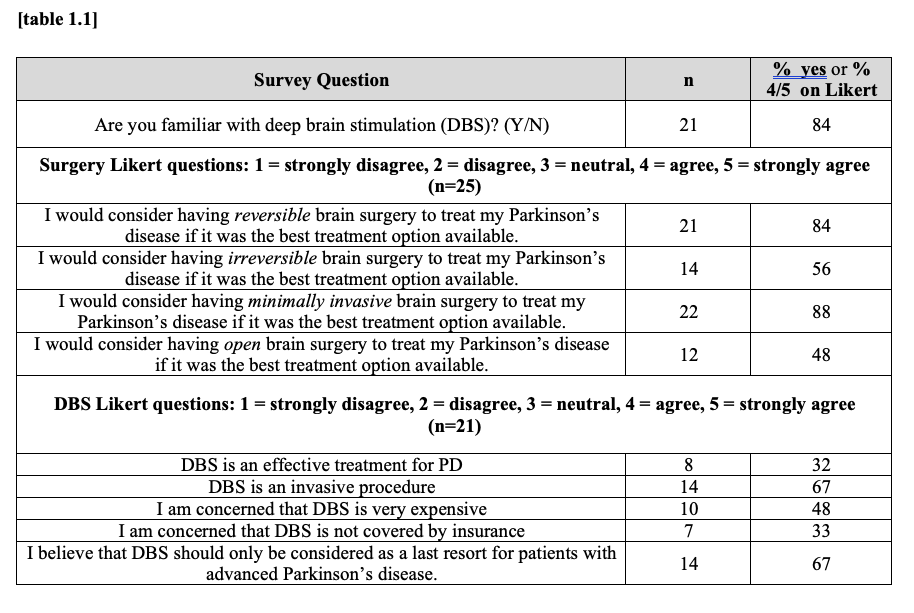Session Information
Date: Wednesday, September 25, 2019
Session Title: Surgical Therapy
Session Time: 1:15pm-2:45pm
Location: Les Muses Terrace, Level 3
Objective: To examine perceptions of Deep Brain Stimulation (DBS) in patients with Parkinson’s Disease (PD), with the aim of understanding common fears and concerns about the procedure
Background: DBS has become an increasingly common treatment for PD since its FDA approval in 2002. Its effectiveness in managing refractory PD is extensively documented [1], and there is a growing body of research suggesting that earlier stimulation may benefit patients [2]. However, previous research has noted that only 10% of the 15% of advanced PD patients that are eligible for DBS are referred for surgery [3], and that 45% of patients undergoing the procedure still have reluctance about it [4]. Understanding how PD patients conceptualize this procedure is necessary in order to address potential barriers to treatment.
Method: A 30 item questionnaire was administered to patients with PD following up at our institution who had not received prior neurosurgical consultation about DBS. The survey assessed three domains: familiarity with DBS, perceptions on hypothetical PD surgical characteristics, and perceptions about DBS. Perceptions were analyzed by using five point Likert-item and two-point dichotomous (Y/N) questions.
Results: In our cohort of 25 patients, 84% of patients were familiar with DBS, with the highest percentage of patients having first heard about it from the internet (n=9). Patients displayed significant heterogeneity when asked about hypothetical surgical invasiveness and reversibility. Of patients familiar with the procedure, 32% (n=8) considered DBS effective, and 56% of patients (n=14) considered DBS invasive. Almost half of the cohort (n=10) were concerned that DBS is very expensive. Over half (56%) of patients considered DBS as a last resort treatment. Our results are reported in [table 1.1].
Conclusion: Our study suggests that there is wide variability in patient perceptions about safety, costs, efficacy, and benefits of DBS. Patients furthermore responded strongly to questions about surgery invasiveness and reversibility, suggesting that proper patient education about these procedures is of vital importance to clinicians. We hope to further characterize the perceptions of a larger cohort of patients with the aim of utilizing this data in future patient education.
References: 1. Weaver, F. M., Follett, K., Stern, M., Hur, K., Harris, C., Marks, W. J., Jr., . . . Huang, G. D. (2009). Bilateral deep brain stimulation vs best medical therapy for patients with advanced Parkinson disease: a randomized controlled trial. Jama, 301(1), 63-73. doi:10.1001/jama.2008.929 2. Schuepbach, W. M., Rau, J., Knudsen, K., Volkmann, J., Krack, P., Timmermann, L., . . . Deuschl, G. (2013). Neurostimulation for Parkinson’s disease with early motor complications. N Engl J Med, 368(7), 610-622. doi:10.1056/NEJMoa1205158 3. Lange, Max, et al. “Underutilization of deep brain stimulation for Parkinson’s disease? A survey on possible clinical reasons.” Acta neurochirurgica 159.5 (2017): 771-778. 4. Kim, M. R., Yun, J. Y., Jeon, B., Lim, Y. H., Kim, K. R., Yang, H. J., & Paek, S. H. (2016). Patients’ reluctance to undergo deep brain stimulation for Parkinson’s disease. Parkinsonism Relat Disord, 23, 91-94. doi:10.1016/j.parkreldis.2015.11.010
To cite this abstract in AMA style:
S. Das, S. Ramesh, M. Baldassari, M. Rasool, J. Ratliff, D. Kremens, T. Alexander, C. Matias, TW. Liang, C. Wu. Evaluating Perceptions of Deep Brain Stimulation in DBS-naïve Patients with Parkinson’s Disease – A Pilot Study [abstract]. Mov Disord. 2019; 34 (suppl 2). https://www.mdsabstracts.org/abstract/evaluating-perceptions-of-deep-brain-stimulation-in-dbs-naive-patients-with-parkinsons-disease-a-pilot-study/. Accessed November 8, 2025.« Back to 2019 International Congress
MDS Abstracts - https://www.mdsabstracts.org/abstract/evaluating-perceptions-of-deep-brain-stimulation-in-dbs-naive-patients-with-parkinsons-disease-a-pilot-study/

